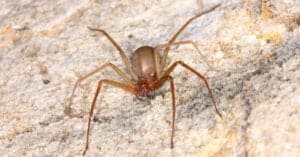Illinois, located in the heartland of America, is known for its stunning landscapes, picturesque towns, and diverse range of wildlife. Among the many creatures inhabiting this state, the spiders stand out as both fascinating and potentially dangerous. These eight-legged arachnids are common in many homes and gardens across Illinois. While some species are harmless, others can deliver a venomous bite that can cause serious health problems.
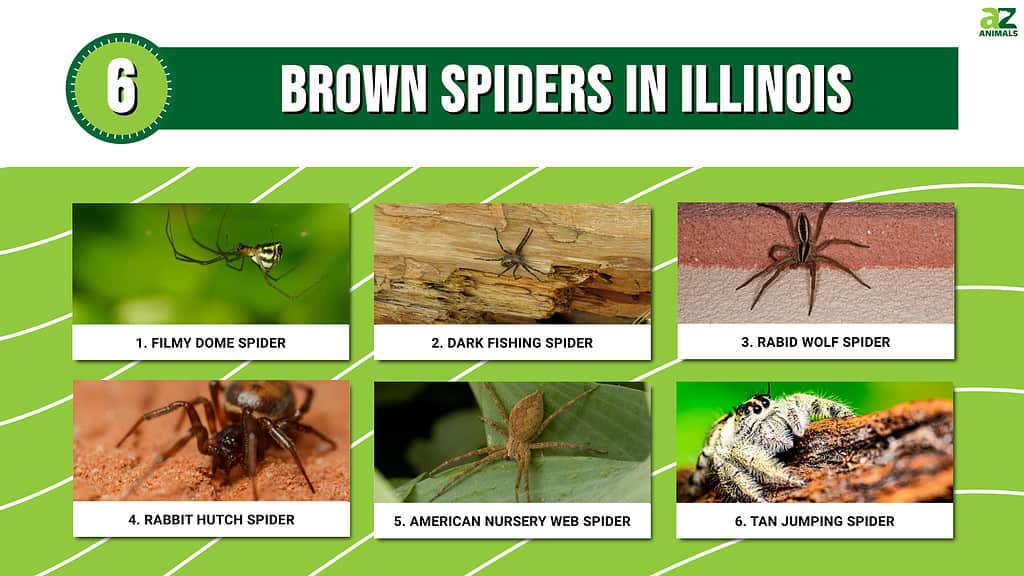
In this article, we will explore the world of brown spiders in Illinois. We’ll look at the different species that can be found in the state and the characteristics that make them unique.
Brown Spiders in Illinois: Filmy Dome Spider (Neriene radiate)
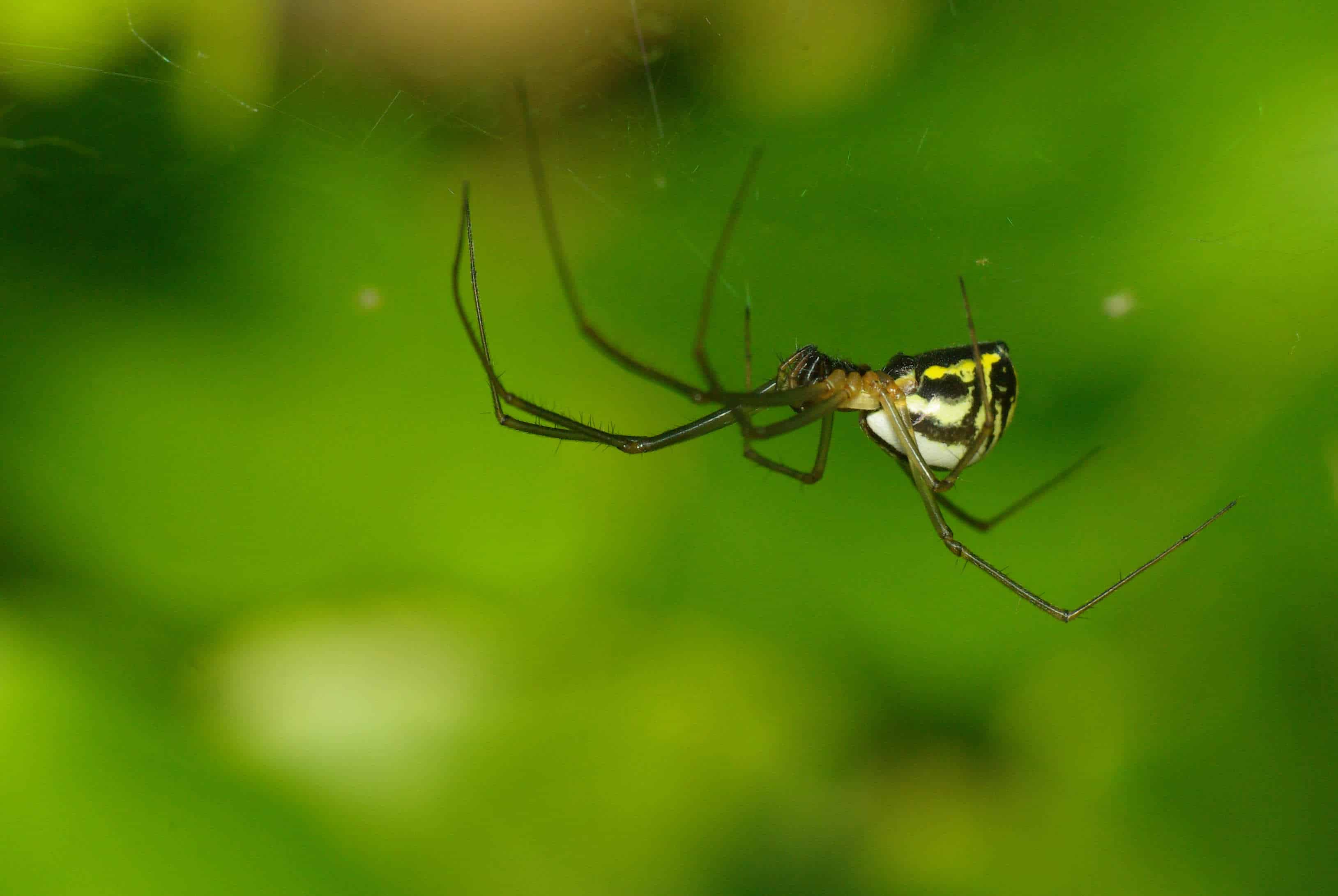
The filmy dome spider prefers woodlands and areas with dense vegetation, often found near houses.
©DeRebus/Shutterstock.com
The filmy dome spider is very small, with a body measuring around 0.25 inches (including legs). Its body coloration typically includes brown or black hues and straight yellow and white stripes on the abdomen. In some species, the spider’s body displays a combination of white and black, with a brown head.
One interesting behavior of the filmy dome spider is that it creates its web as a dome. The unique aspect of this structure is that it is inverted. This can cause confusion for potential prey and lead to them becoming entangled in the web.
The filmy dome spider prefers woodlands and areas with dense vegetation, often found near houses. Its webs are commonly seen on wood piles, walls, and low brush in woodlands, but it avoids open areas.
These spiders prey on small insects like gnats and mosquitoes that become trapped in their horizontal web. To catch its prey, the spider tears a hole in the web from beneath and pulls the insect down to immobilize it. This spider hides under its web, which provides protection against predators.
The bite of the filmy dome spider does not pose any danger to humans. But it may cause slight discomfort, such as itching.
Fun Facts
- This spider species can be found in almost every country around the world.
- While female Neriene radiata spiders have the ability to create webs, males do not possess this capability.
- In a span of less than a year, Neriene radiata undergoes all the stages of its life cycle. It eventually dies after laying eggs in the winter.
Brown Spiders in Illinois: Dark Fishing Spider (Dolomedes tenebrosus)
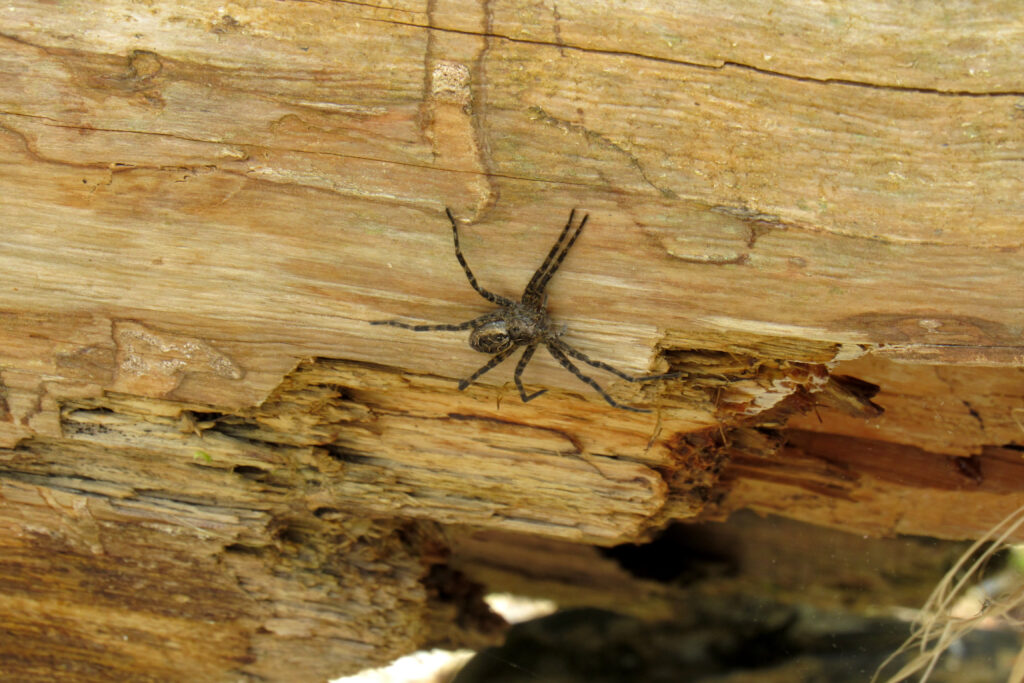
Dark fishing spiders are known to pursue their prey, such as small fish and aquatic insects, by running freely over water, and they can even dive beneath the surface when threatened.
©Bailey Davenport/Shutterstock.com
The dark fishing spider, which belongs to the family of fishing spiders, is a familiar species in Illinois. The dark fishing spider is often confused with other spider species, such as tarantulas, wolf spiders, and barn funnel spiders. Its appearance is characterized by brown and mottled black coloration. It also has limited white markings and dark W-shaped patterns on the upper surface of its abdomen. Its legs are typically held almost straight out and banded with brown.
Females of this species are larger than males. Female bodies are approximately 1 inch long and have a total length of over 3 inches when outstretched. In contrast, males are about half the size of females.
Dark fishing spiders are known to pursue their prey, such as small fish and aquatic insects, by running freely over water, and they can even dive beneath the surface when threatened. Despite their name, dark fishing spiders do not solely inhabit areas near water. While they are frequently observed around permanent water sources near rocks, shrubs, and vegetation, they can also be found in dry wooded regions.
Dark Fishing Spider Characteristics
The diet of dark fishing spiders consists of insects, small fish, and small arthropods, which they capture by pouncing on their prey and biting it. Unlike web-building spiders, which rely on vibrations within their web to detect prey due to their poor vision, running spiders, such as the Dark fishing spider, have good vision.
Although capable of biting humans, the dark fishing spider will typically flee from people. The bite of the dark fishing spider generally results in mild symptoms similar to that of a bee or wasp sting.
Fun Facts
- Dark fishing spiders are frequently observed walking on both ground and trees.
- Their lifespan ranges from 1 to 2 years.
- Some people consider them excellent pets.
Brown Spiders in Illinois: Rabid Wolf Spider (Rabidosa rabida)
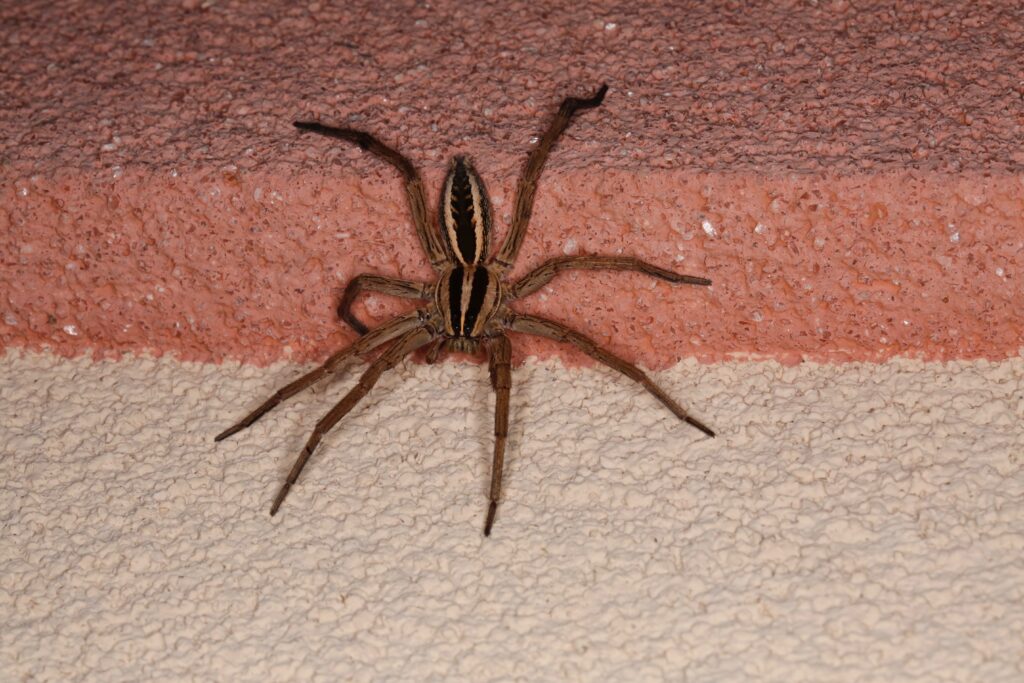
This spider species possesses a unique trait that sets it apart from others – its eyes reflect light like that of dogs and cats, particularly noticeable during the nighttime.
©Cathleen Wake Gorbatenko/Shutterstock.com
The Lycosidae family is home to the fast-moving rapid wolf spider, which is often found in the state of Illinois.
The spider is characterized by its light brown coloration and is marked by two thick, dark brown stripes on either side of its head. Its tan body has a dark brown center line running down the abdomen and two thinner brown lines along its sides.
This spider species possesses a unique trait that sets it apart from others – its eyes reflect light like that of dogs and cats, particularly noticeable during the nighttime. The total body of a female falls within the range of 0.63 to 0.83 inches, while males are shorter.
The rabid wolf spider is a formidable predator known for its active hunting style. These spiders pursue their prey with remarkable agility and speed.
While they may occasionally lie in wait for their prey to come close enough, they are not known to spin webs or sit in them.
Rabid Wolf Spider Characteristics
This particular species prefers habitats such as cotton fields and wooded areas. They are known to reside in various locations, including holes and in the garbage. Additionally, they may be found around ponds or deep burrows, which they tend to cover with debris.
Carnivorous in nature, these spiders prefer small prey, including but not limited to crickets, grasshoppers, ants, and other spiders. Their diet makes them excellent ecological controllers, as they play a significant role in regulating the population of pest insects.
While its name may evoke fear, the rabid wolf spider does not threaten humans or carry rabies. This spider species is harmless to people and will typically avoid contact whenever possible.
Fun Facts
- Erratic and fast-moving spiders with frenzied movements.
- The spider has small white eyebrow-like marks located behind the eyes that aid in identifying this species.
- Spiderlings are observed to be attached to their mother’s backs when they are young.
Brown Spiders in Illinois: Rabbit Hutch Spider (Steatoda bipunctata)
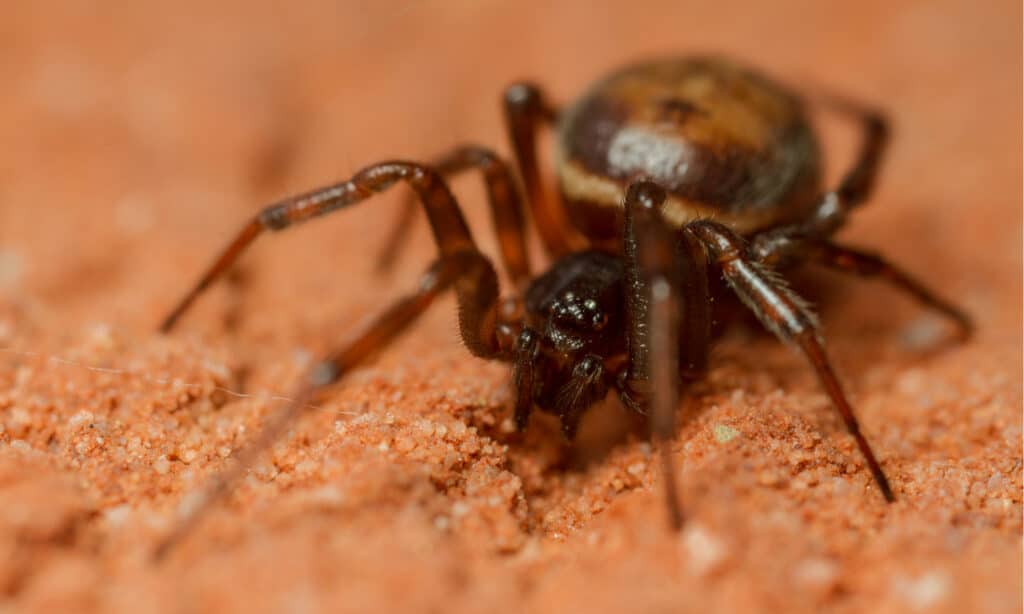
Rabbit Hutch Spider (
Steatoda bipunctata).
©thatmacroguy/Shutterstock.com
If you want to spot the rabbit hutch spider, it’s best to keep an eye out around human structures in Illinois.
The spider’s chestnut brown abdomen is shiny and often has a thin pale band stretching across the front, which features a white ‘V’ shape just behind the head. The rabbit hutch spider’s abdomen has four small notches on its back that are anchoring points for internal muscles since the spider lacks an internal skeleton.
The female rabbit hutch spider measures approximately 0.27 inches, while the males are smaller, measuring around 0.19 inches.
The rabbit hutch spider is nocturnal and not commonly spotted. It prefers quiet and secluded areas near man-made structures, where it weaves a discreet “scaffold” web.
Rabbit Hutch Spider Characteristics
The rabbit hutch spider gets its name from its tendency to thrive in rabbit hutches, which serve as a suitable habitat. Aside from man-made buildings, these spiders are also commonly found outdoors, typically in gardens and bushes. They are known to take refuge in rock crevices, under tree bark, or stones.
The rabbit hutch spider’s diet consists of any unsuspecting prey that happens to stumble into its web, such as woodlice.
Although they resemble black widow spiders, rabbit hutch spiders are not as venomous as the widow family, and their fangs are too small to inflict a painful bite in humans.
Fun Facts
- The rabbit hutch spider’s web appears as a tangled and dirty mesh.
- These spiders provide beneficial contributions to humans.
- While present throughout the year, the males of the species are primarily active during mating season.
Brown Spiders in Illinois: American Nursery Web Spider (Pisaurina mira)
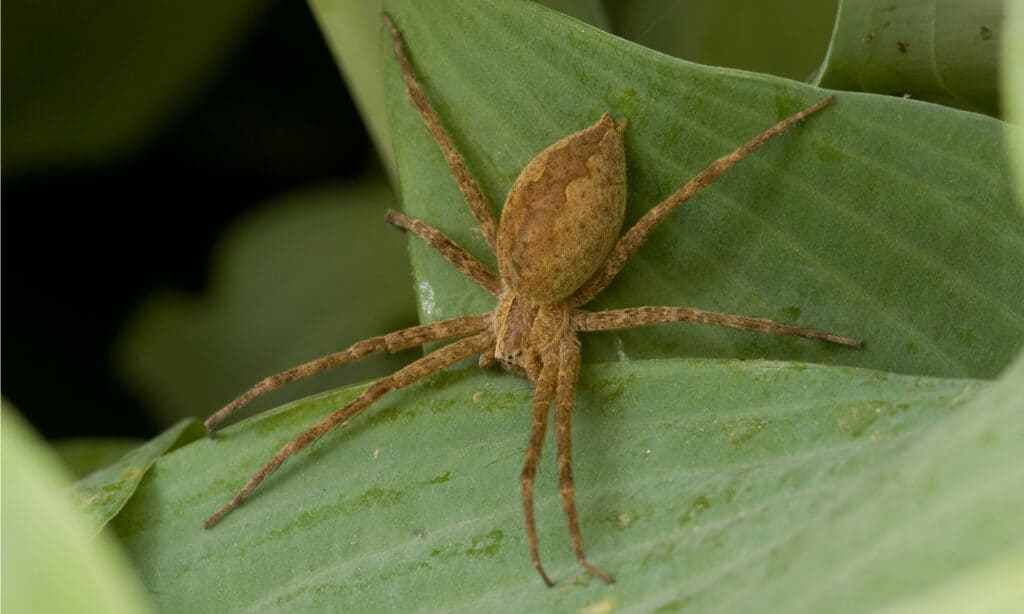
Male American nursery web spiders will tie females’ legs during mating to avoid being eaten afterward.
©SDeming/Shutterstock.com
The state of Illinois is home to a spider species known as Pisaurina mira, which can be found throughout the region. This particular arachnid is frequently encountered in woodland areas.
American nursery web spiders display a range of brown hues in both genders, with some having a distinct brown stripe running along their backs. A thin white edging is visible around their abdomens. These spiders are often misidentified as wolf spiders, as they share similar physical characteristics.
The females and males of this species can grow up to approximately three-quarters of an inch in length, with males usually being slightly smaller.
The male Pisaurina mira spiders have a unique way of courting their potential mates. They present a “nuptial gift” to the female by capturing a fly or another insect and encasing it in a cocoon, which they then present to the female. This gesture can be prolonged and repeated several times. Despite this, not all female spiders are receptive to mating and may pose a threat to their suitors.
American Nursery Web Spider Characteristics
These spiders occupy various habitats in Illinois, including meadows, fields, and forests. They are known to favor tall grass, bushes, and shrubs as their dwelling places. Although primarily found in outdoor settings, these spiders may occasionally reside inside homes as well.
Unlike the common spider that spins webs to ensnare prey, the American nursery web spider is an active hunter. These spiders do not wait for insects to land on their webs. Instead, they actively roam over vegetation, searching for small insects to capture. They are known for their agility and speed in catching their prey. However, the spider does spin a web to hold its egg sac and hatched spiderlings, hence the name of the species “nursery spider.”
As with most spider species, the venom of Pisaurina mira is highly effective against the small animals, such as insects, that it preys upon. However, it is not potent enough to cause harm to larger animals or humans.
Fun Facts
- Pisaurina mira spiders may prey on small mammals, birds, and amphibians.
- Mating season for this species occurs between mid-June and mid-July.
- Female American nursery web spiders exhibit high parental care toward their young.
Brown Spiders in Illinois: Tan Jumping Spider (Platycryptus undatus)

Tan jumping spiders prey on small insects such as flies, crickets, aphids, mealworms, roaches, and other smaller spiders.
©iStock.com/graphixchon
Illinois is home to various jumping spiders, including Platycryptus undatus, also known as the tan jumping spider.
The tan jumping spiders have a predominantly brown coloration but also display white and black spots and red markings around their eyes. Their flattened vertical body shape and unique striped abdomen pattern make them challenging to spot when they traverse across mottled surfaces.
As for their physical dimensions, female tan jumping spiders range from 0.39 to 0.51 inches, while males measure between 0.33 and 0.37 inches.
While other spider species construct webs to ensnare prey, the tan jumping spider utilizes a different hunting technique. They do not spin webs; instead, they patiently stalk their prey and use their remarkable jumping ability to strike with pinpoint accuracy.
They are often seen clinging to vertical surfaces such as fence posts and tree trunks. During late autumn, these spiders are not uncommon to explore the walls inside houses.
As is typical of most jumping spiders, the tan jumping spider preys on small insects such as flies, crickets, aphids, mealworms, roaches, and other smaller spiders.
Although the tan jumping spider possesses venoms potent enough to subdue its prey, they do not harm humans. In the unlikely event of a bite, the most noticeable symptoms would be mild redness and irritation, which usually disappear after a few days.
Fun Facts
- The tan jumping spider is a friendly arachnid that can make an easy-to-keep pet.
- Unlike other jumping spider species with a lifespan of up to six months, the tan jumping spider can live up to three years.
- These spiders may fall prey to various predators, such as birds, mammals, wasps, and reptiles.
Bonus: What Keeps Spiders Away?

Spiders find certain essential oil scents repugnant like peppermint oil.
©Tatevosian Yana/Shutterstock.com
One of a person’s worst nightmares is having spiders wind up in their home–especially the poisonous kind! The best way to avoid getting bitten by a spider is to try and prevent them from entering your house in the first place. As spiders can get into your home through holes and cracks, you can check for possible entryways with a flashlight. If the light gets through from the inside to the outside, you should fill that hole or crevice with an appropriate product.
Keeping your yard free of debris and overgrown vegetation helps cut down on areas spiders would gravitate to. Caulking doors and windows is also a good strategy to keep them out.
Spiders hate certain scents, so scented essential oils can help deter them like peppermint, tea-tree, lavender, and rose. You can add 15-20 drops of a particular oil in a water bottle mixed with water and spritz it around your house. They also hate the smell of cinnamon and vinegar, so these scents can be used similarly.
Regular cleaning inside your home, especially in areas that are dark or less frequented, is necessary to keep spiders from setting up residence. It’s also important to keep an eye on fruit bowls, as they can attract spiders.
Thank you for reading! Have some feedback for us? Contact the AZ Animals editorial team.







